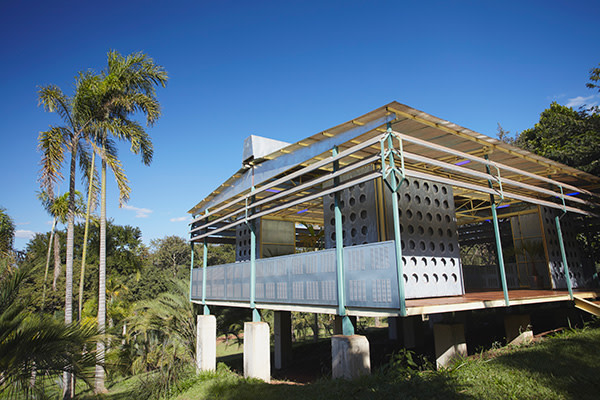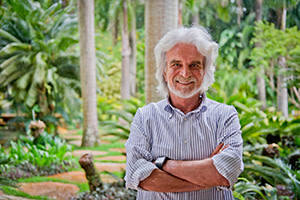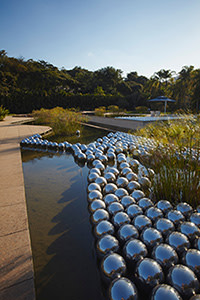Brazil’s Inhotim is an art lover’s paradise

Simply sign up to the Life & Arts myFT Digest -- delivered directly to your inbox.
The most impressive, and unexpected, display of contemporary art you’re ever likely to see – if you’re prepared to undertake the journey to reach it – is just outside a remote town in rural Brazil. A few miles from Brumadinho in the southwestern state of Minas Gerais, the mining tycoon Bernardo Paz has spent the past 15 years building an art park and nature reserve called Inhotim in 3,000 acres of forest and farmland. There are career-defining works here by some of the greatest artists of our age, from the Americans Matthew Barney and Chris Burden to the Canadian duo Janet Cardiff and George Bures Miller, the Colombian sculptor Doris Salcedo, the Japanese artist Yayoi Kusama, the Italian Giuseppe Penone, and many others.
What Paz and his team of curators have created here must rank among the most ambitious and original contemporary art museums ever conceived. There is no single, monolithic building designed by a famous architect of the kind favoured by most institutions across the world. Instead there are 22 galleries scattered in the vast, immaculately manicured landscape, which are connected via stone paths meandering through lush vegetation.
Some of these buildings are perched on the edge of emerald-green artificial lakes, others are hidden in the forest or positioned on top of steep hills with imposing views of the surrounding region. A further 22 outdoor sculptures are dotted throughout the site. So a visit to Inhotim is part gallery visit and part nature hike, a combination that is surprisingly successful.
“Most museums are places where people go for an hour or two before reaching a state of fatigue,” says Allan Schwartzman, the New York-based art adviser who serves as chief curator at Inhotim. “Most people come to Inhotim for a full day and tend to leave refreshed rather than exhausted.”
So who is the man behind this radically new approach to showing art? I meet Bernardo Paz in a discreet office building at the heart of the immense site. With his shoulder-length grey hair, white beard and flowing linen clothing, Paz, 63, looks like an ageing hippy. He speaks quickly in broken English, chain-smoking menthol cigarettes as he talks. Inhotim, he says, is “for the future, for eternity. It will be here 1,000 years.”

Since stepping down from active management of his mining company, Itaminas, more than a decade ago, Paz has lived with a singular obsession: to create a place that will become known throughout the world for the excellence of its displays and programming. Although Inhotim is already enormous – altogether its pavilions contain about 115,000 sq ft of exhibition space, making them roughly one-third larger than the galleries at Tate Modern in London – it is going to get much bigger, and fast. Paz hopes there will eventually be 40 pavilions and galleries on the site, as well as many new outdoor sculptures. A hotel with 80 bedrooms and a luxury spa is under construction and will open next summer, the first of several at various price levels Paz wants to build here. When the site reaches its full expansion “it will take 10 or 12 days for you to see everything,” he says.
Paz talks of launching theatre and film festivals and plans for a biennial think-tank devoted to tackling the global challenges of our day, such as climate change. “My goal is to bring here every two years the 10 best thinkers in the world,” he says. These initiatives are all part of a scheme to make Inhotim financially sustainable for the future – it currently takes $18m a year just to keep it running, and this excludes the cost of new building. Much of this money comes from Paz, who is worth some $817m, according to Forbes, a fortune made by selling iron ore to China. He intends to spend all of it on Inhotim. “I don’t believe in giving money to children after you die,” explains Paz, who has seven children, scattered throughout the world from Germany to Hawaii, from six marriages. “I told them [when] I die, they will have nothing . . . They understand, they know this is my life and my vision.”
He first became interested in art through his friendships with Brazilian artists such as Tunga and Cildo Meireles, who both have pavilions showing their work at Inhotim. A recently opened 30,000 sq ft gallery devoted to Tunga includes several signature pieces from throughout his career and amounts to a permanent retrospective exhibition that is unlikely ever to be bettered. Meireles too is represented here by some of his most important works, such as “Red Shift”, conceived in 1967 and consisting of a series of interlinked rooms where all the furniture, fittings and decorations are red. A version of this installation was the centrepiece of Tate Modern’s 2008 Meireles exhibition.

The premise behind these displays is simple: in every instance the curators aim either to choose an artist’s best existing work, to commission him or her to create a new, site-specific project, or to realise a project that has hitherto been impossible to create. “We want the most amazing works to be realised there,” says Schwartzmann. The American artist Doug Aitken is a case in point. He is represented at Inhotim by his “Sonic Pavilion”, which was completed in 2009 and consists of a circular building on top of a hill with a well at its centre. At its bottom, microphones capture the sounds of the earth, which are then amplified and played live in the gallery above. It was a work the artist had thought about for years before Schwartzmann encouraged him to build it at Inhotim.
New projects currently in the planning or construction phase include the installation of four major pieces by Anish Kapoor. The first of these to open next year, “Shooting into the Corner”, will be housed in its own building. It consists of a cannon that fires balls of red wax against a gallery wall, and was included in the artist’s exhibition at the Royal Academy in London in 2009. Another work by Kapoor, to be sited outdoors, will be a “slash in the landscape that will extend for a quarter of a mile or longer so it looks like the earth has been cracked open”, explains Schwartzmann. “It will be a spatial void that you can’t gauge the depth of [and will have] enormous visual impact.”
The Scandinavian artist Olafur Eliasson is also working on new projects at Inhotim: one is a building with a lateral slat cutting through it at eye level that shows the horizon, and the other is described by Schwartzmann as a “sculptural version of a sundial”, an outdoor installation consisting of a sphere cut into the earth. “As you descend down into it, you look up to see the top of the piece track the sun as it moves in the sky.”
Other galleries opening soon will include one devoted to hundreds of photographs of Brazil’s indigenous Yanomami tribes taken by the Swiss-born, Brazilian-based Claudia Andujar over the past 50 years, pavilions to house major works by Doris Salcedo, who already has one gallery devoted to her work at Inhotim, and the American land artist Michael Heizer. Meanwhile Robert Irwin is realising a new outdoor sculpture.
Since opening to the public in 2006, Inhotim has welcomed more than 1m visitors, the majority from the surrounding area. Paz is particularly proud of this, as he is of employing about 1,000 staff on the site, many of them locals. “All the poor [young people] from here who before had the dream of becoming a truck driver [now have greater ambitions],” he says. “Inhotim is for all the people.”
——————————————-
Letter in response to this article:
‘Jungle’ headline was wide of mark / From Mr Bernardo Frydman
Comments